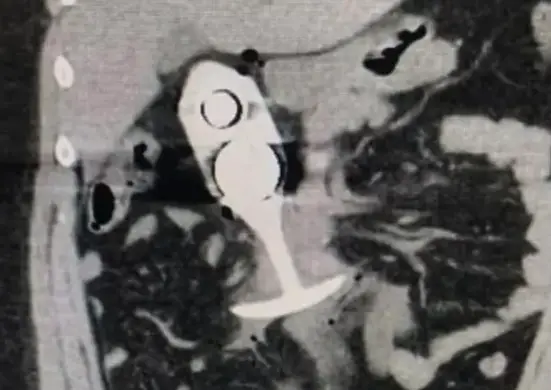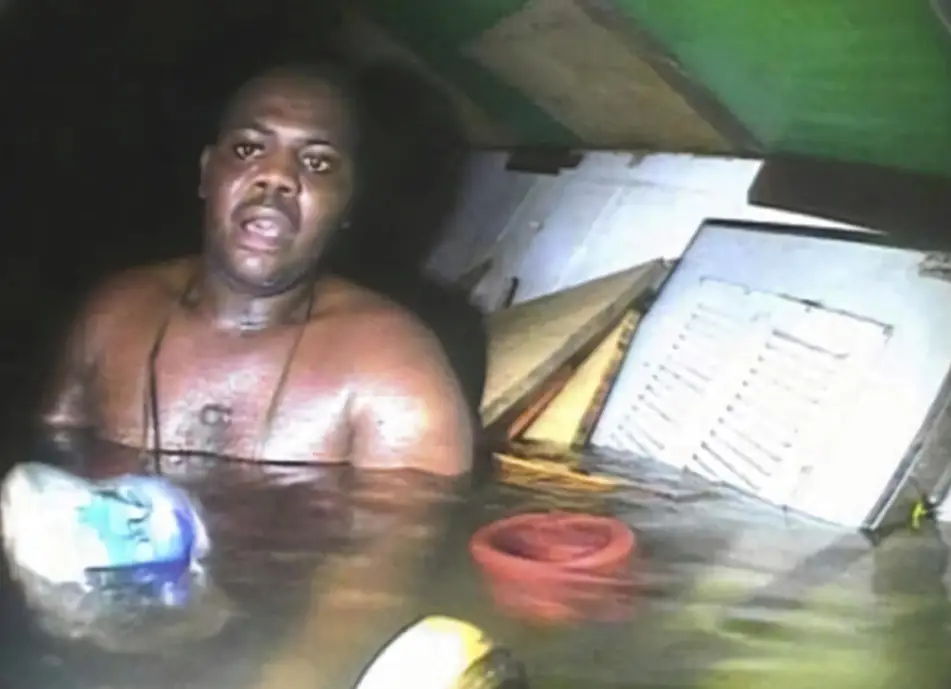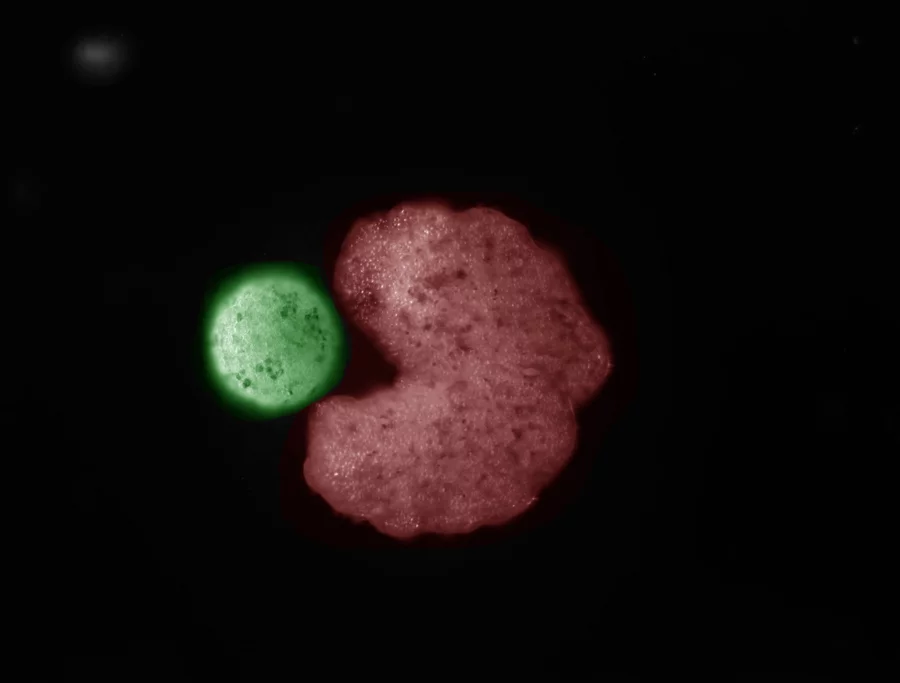Weird Anglerfish Mating Strategy: What Happens to Male Anglerfish?

Unique Male Anglerfish
Male anglerfish are known for their unusual method of reproduction, becoming a permanent fixture on the much larger females.
These tiny males, often less than a centimeter in size, spend their existence searching for a partner in the vast, dark ocean. Once they find a female, they bite onto her body, and their tissues fuse together.
After attaching to a female, the male’s digestive system degenerates, making him dependent on her for nutrients via their shared bloodstream.
A female anglerfish can carry multiple male partners, each one fused to different parts of her body. For some species, like the footballfish, this bonding is for life.
Scientists are still unraveling the mysteries of anglerfish mating. These fish have made significant adaptations, such as reducing their immune system to tolerate this form of cohabitation.
The males trade their independence for a lifelong sustenance connection with a female.
Beyond their unique mating, male anglerfish’s existence raises questions about evolution, survival, and life in the Earth’s most inhospitable places.

Mating Strategy
The mating strategy employed by anglerfish, often called “sexual parasitism,” is a sophisticated adaptation to the deep-sea life’s challenges.
In this dark world, where mates are sparse, the anglerfish’s approach eliminates the need for repeated mate searching, saving energy in a food-scarce environment.
The permanent fusion of males to females is an ingenious survival strategy tailored for the abyss.
Through a genetic connection, the bond formed is not just physical but also physiological.
Males, equipped with developed olfactory organs, can detect specific pheromones emitted by the females, leading them through darkness to their partners.
After attachment, the male’s body undergoes a remarkable transformation, with many of his organs atrophying and disappearing, leaving him as a life-support system and sperm provider for the female.
This extreme specialization raises questions about the cost of evolution. What does it mean for these fish to sacrifice so much for reproduction?
How does losing bodily autonomy benefit the male or the species? These sacrifices facilitate an almost guaranteed opportunity to pass on genes—a key factor in the survival game.
This adaptation marks an extraordinary route, diverging from more recognizable forms of sexual reproduction and partnership in the natural world.
The anglerfish’s reproductive strategies also open doors to understanding how life can adapt to inhospitable environments.
As researchers delve into the genetic and immunological consequences of these strategies, we may discover pathways for new medical insights and therapies, particularly concerning immune system functioning and organ transplantation.
Ultimately, the anglerfish encourages us to expand our perceptions of life’s possibilities.
In a universe of varied environments and living conditions, life has a remarkable capacity to find a way to survive and thrive.
The deep sea, with inhabitants like the anglerfish, remains one of the last great mysteries on earth, reminding us of our planet’s depth and complexity.
As we explore these frontiers, we may uncover other marvels and strategies for survival.

Genetic and Immune Adaptations
The genetic and immune adaptations that underpin the anglerfish’s unique mating strategy are revolutionary from an evolutionary biology perspective.
These deep-sea fish present a fascinating case study of life’s adaptability, exhibiting radical genetic modifications that allow them to engage in an extreme form of codependency.
Anglerfish have developed a way to sidestep the issue of immune response, which typically would result in the male being rejected as foreign tissue upon attempting to fuse with the female.
Instead, anglerfish have undergone significant alterations to their immune system genes, particularly those involved in adaptive immunity.
Adaptive immunity allows organisms to attack foreign invaders specifically and with memory; however, it also prevents tissues from different organisms from easily merging.
For anglerfish, the cost of this sophisticated immune system is too high if it means loneliness in the vast darkness of the deep sea.
Anglerfish exhibit immune system suppression: alterations in genes that drastically reduce or might completely shut down the capability to reject tissue through the adaptive immune system.
This is accomplished by modifications to the major histocompatibility complex (MHC) molecules, critical players in the body’s immune system that normally alert an organism to the presence of foreign invaders.
Reduced functionality or absence of these molecules allows for the male anglerfish’s tissue to blend seamlessly with that of the female.
Even more intriguing is the adaptation seen concerning the anglerfish’s adaptive immune genes responsible for antibody production and cytotoxic T cell responses.
These critical components of a typical vertebrate’s defense against pathogens are significantly altered or even absent in these deep-sea dwellers.
It poses the realization that evolution, under the right pressure, can not only sculpt new traits but can reduce features previously considered indispensable.
This radical genomic remodeling affords an angle into how life can find ways to circumnavigate biological hurdles as massive as immune reaction for survival.
Yet, it leaves unanswered questions about how the anglerfish defends against infections without a conventional adaptive immune system.
The unique immune footprint of these creatures suggests the augmentation or heightened ability of their innate immunity, potentially offering clues into novel immunological pathways.
Anglerfish genetic novelties provide transformative insights into possible human applications.
Therapies that could modulate the human immune system for better compatibility during organ transplants or novel methodologies in treating autoimmune diseases are areas ripe for scientific inquiry and innovation inspired by anglerfish.
In navigating the dark waters of their home, anglerfish not only adapted to survive but unknowingly became beacons for understanding biological constraints and capabilities.
Their evolutionary trajectory, marked by biological innovation for reproductive assurance, stands as a testament to life’s drive for continuation against the odds.
This saga challenges our perceptions and expands our understanding of evolution, pushing the boundaries of what we consider the norm in nature.
Watch: The Bizarre Way the Anglerfish Mates
Reproductive Success
In the vast realms of the deep sea, where life teeters on the brink of impossibility, the anglerfish’s mating strategy emerges as a masterstroke for reproductive success.
Given the scarcity of mates in this underwater wilderness, finding another individual is akin to locating a needle in a cosmic haystack.
The solution? A permanent bond that ensures when a female anglerfish encounters a male, she utilizes this rare opportunity to its fullest extent.
Sexual parasitism, though unusual, is attuned to the realities of deep-sea living.
For males, the search for a mate is a dangerous endeavor with no promise of success; it’s resource-intensive and perilous in an environment where the slightest misstep can prove fatal.
By fusing with a female, male anglerfish relinquish their autonomy but invest in a reproductive strategy that guarantees genetic continuance with minimal energy expenditure.
Females gain a ready reserve of sperm, enabling them to fertilize their eggs whenever conditions are most favorable, without the need for a mate-finding odyssey.
This “on-demand” reproductive assistance is critical in an environment where timing and conditions for spawning can be crucial.
By carrying multiple males, a female further ensures a diverse genetic contribution to her offspring, enhancing their resilience and potential adaptability to the harshness of deep-sea life.
However, this evolutionary strategy is not without potential pitfalls. The suppression of the immune system necessary for males to fuse with females may render these fish more vulnerable to diseases.
Yet, this adaptation likely comes with some form of compensatory mechanism—a bolstered innate immunity or an environment where pathogens are less prevalent or virulent.
Moreover, the energetics behind supporting multiple parasitic males carry a resource demand for the female.
While the males are dependent on females for sustenance, females must secure enough nutrition not only to survive but to provide for their riders.
This necessity potentially influences female anglerfish behavior and physiology, possibly leading them to evolve additional means of attracting and consuming prey.
In the economy of nature’s depths, the anglerfish’s strategy represents a pragmatic balance between the cost of maintaining parasitic mates and the imperatives of reproduction.
The enormity of the deep-sea environment, with its sparse population and meager resources, crafted a solution that may seem unconventional, yet undeniably effective for the continuation of the species.
It embraces the solitary vastness of their realm, turning an overwhelming challenge into an evolutionary advantage that speaks volumes of nature’s creativity in fostering life against the odds.
The anglerfish teaches us that reproductive success in the natural world involves nuanced strategies intertwining survival and genetic legacy.
Theirs is a tale of life finding a way, even in the most desolate reaches of our planet, refining our understanding of biological adaptation and the myriad forms that survival can take.

Evolutionary Perspective
The tale of the anglerfish and its extreme mating ritual is a vibrant chapter in the story of evolutionary innovation.
By examining this deep-sea enigma through the lens of evolutionary biology, we can discern broader patterns and lessons about survival, adaptation, and the relentless march of life through our planet’s history.
At its heart, the saga of anglerfish reproduction is one of evolutionary opportunism.
In the brutal arena of the deep sea—a realm devoid of sunlight, teeming with immense pressure and scarce resources—life must either adapt or perish.
The anglerfish’s strategy of sexual parasitism is a masterclass in adaptive problem-solving.
It’s a solution born from the depths of evolutionary pressure, where the improbable becomes the inevitable.
Such life strategies illuminate the crux of evolutionary theory: that necessity drives innovation.
The anglerfish has tailored its reproductive behavior not just to overcome the challenges of its environment but to turn these obstacles into assets.
This ability to turn adversity into advantage speaks to the potential pathways evolution can take, often resulting in solutions that defy convention.
Furthermore, the anglerfish scenario sheds light on the concept of evolutionary trade-offs.
The decision for these fish to reduce their immune systems for the sake of reproductive assurance is a reminder that evolution often operates on a currency of compromise.
What is lost in one area may be gained in another, balancing the scales in a way that favors the overall fitness of the organism within its specific niche.
It posits a question: What other evolutionary trade-offs have occurred unnoticed in the shadowy corners of our world, crafting the bizarre tapestry of life in response to environmental challenges?
The deep sea, often likened to an alien world, is home to myriad creatures that have undergone their own dramatic evolutionary journeys.
As scientists peel back the layers on these biological mysteries, we’re granted a clearer view of life’s capacity for adaptability.
The anglerfish, with its peculiar approach to partnership and procreation, stands as a testament to this adaptability.
It beckons us to ponder how many other marvels lie concealed in the abyss, awaiting discovery—each with its unique lessons on the mechanics of evolution and survival.
From enhancing disease resistance to refining our approach to complex biological dilemmas such as organ transplantation, the evolutionary wisdom encoded in the anglerfish’s life strategy offers untapped potential.
It showcases evolution not as a linear path but as a web of possibilities, each twist and turn dictated by the primal necessity to endure.
In zooming out to embrace this wider evolutionary perspective, we come to appreciate the anglerfish not merely as an oddity but as a beacon guiding us through the convoluted pathways of life’s expansive narrative.
As earth’s most extreme environments continue to unveil their secrets, they challenge us to expand our understanding and appreciation for the intricate dance of evolution that has composed the myriad forms of life inhabiting our planet.



































